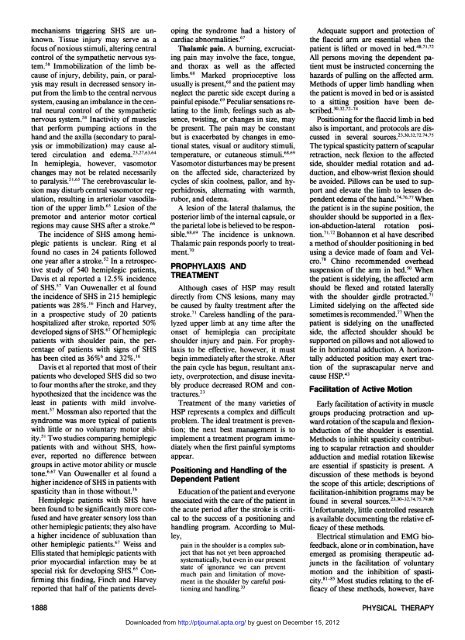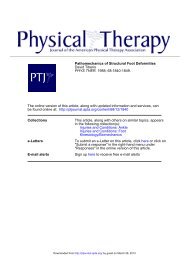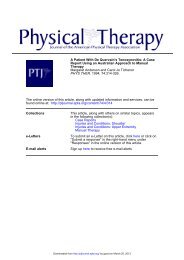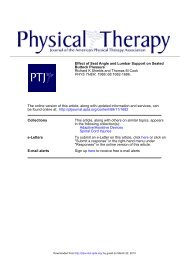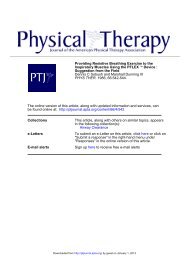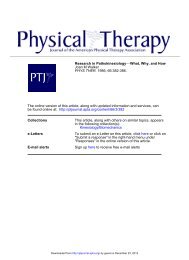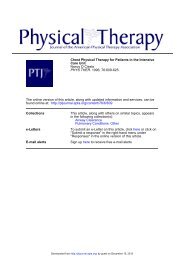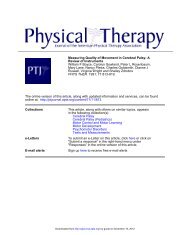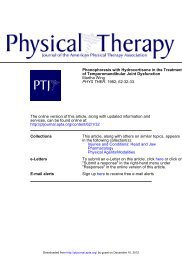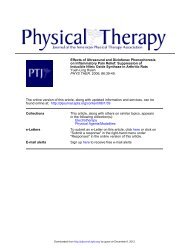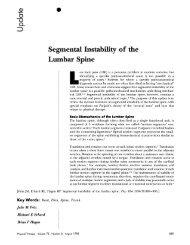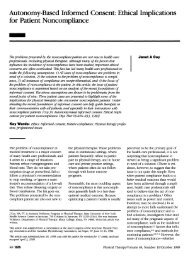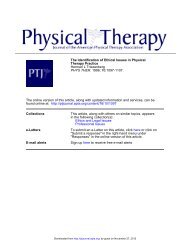Hemiplegic Shoulder Pain - Physical Therapy
Hemiplegic Shoulder Pain - Physical Therapy
Hemiplegic Shoulder Pain - Physical Therapy
You also want an ePaper? Increase the reach of your titles
YUMPU automatically turns print PDFs into web optimized ePapers that Google loves.
mechanisms triggering SHS are unknown.<br />
Tissue injury may serve as a<br />
focus of noxious stimuli, altering central<br />
control of the sympathetic nervous system.<br />
58 Immobilization of the limb because<br />
of injury, debility, pain, or paralysis<br />
may result in decreased sensory input<br />
from the limb to the central nervous<br />
system, causing an imbalance in the central<br />
neural control of the sympathetic<br />
nervous system. 58 Inactivity of muscles<br />
that perform pumping actions in the<br />
hand and the axilla (secondary to paralysis<br />
or immobilization) may cause altered<br />
circulation and edema. 23,27,63,64<br />
In hemiplegia, however, vasomotor<br />
changes may not be related necessarily<br />
to paralysis. 51,65 The cerebrovascular lesion<br />
may disturb central vasomotor regulation,<br />
resulting in arteriolar vasodilation<br />
of the upper limb. 65 Lesion of the<br />
premotor and anterior motor cortical<br />
regions may cause SHS after a stroke. 66<br />
The incidence of SHS among hemiplegic<br />
patients is unclear. Ring et al<br />
found no cases in 24 patients followed<br />
one year after a stroke. 52 In a retrospective<br />
study of 540 hemiplegic patients,<br />
Davis et al reported a 12.5% incidence<br />
of SHS. 57 Van Ouwenaller et al found<br />
the incidence of SHS in 215 hemiplegic<br />
patients was 28%. 16 Finch and Harvey,<br />
in a prospective study of 20 patients<br />
hospitalized after stroke, reported 50%<br />
developed signs of SHS. 67 Of hemiplegic<br />
patients with shoulder pain, the percentage<br />
of patients with signs of SHS<br />
has been cited as 36% 6 and 32%. 16<br />
Davis et al reported that most of their<br />
patients who developed SHS did so two<br />
to four months after the stroke, and they<br />
hypothesized that the incidence was the<br />
least in patients with mild involvement.<br />
57 Mossman also reported that the<br />
syndrome was more typical of patients<br />
with little or no voluntary motor ability.<br />
51 Two studies comparing hemiplegic<br />
patients with and without SHS, however,<br />
reported no difference between<br />
groups in active motor ability or muscle<br />
tone. 6,67 Van Ouwenaller et al found a<br />
higher incidence of SHS in patients with<br />
spasticity than in those without. 16<br />
<strong>Hemiplegic</strong> patients with SHS have<br />
been found to be significantly more confused<br />
and have greater sensory loss than<br />
other hemiplegic patients; they also have<br />
a higher incidence of subluxation than<br />
other hemiplegic patients. 67 Weiss and<br />
Ellis stated that hemiplegic patients with<br />
prior myocardial infarction may be at<br />
special risk for developing SHS. 65 Confirming<br />
this finding, Finch and Harvey<br />
reported that half of the patients devel<br />
oping the syndrome had a history of<br />
cardiac abnormalities. 67<br />
Thalamic pain. A burning, excruciating<br />
pain may involve the face, tongue,<br />
and thorax as well as the affected<br />
limbs. 68 Marked proprioceptive loss<br />
usually is present, 68 and the patient may<br />
neglect the paretic side except during a<br />
painful episode. 69 Peculiar sensations relating<br />
to the limb, feelings such as absence,<br />
twisting, or changes in size, may<br />
be present. The pain may be constant<br />
but is exacerbated by changes in emotional<br />
states, visual or auditory stimuli,<br />
temperature, or cutaneous stimuli. 68,69<br />
Vasomotor disturbances may be present<br />
on the affected side, characterized by<br />
cycles of skin coolness, pallor, and hyperhidrosis,<br />
alternating with warmth,<br />
rubor, and edema.<br />
A lesion of the lateral thalamus, the<br />
posterior limb of the internal capsule, or<br />
the parietal lobe is believed to be responsible.<br />
68,69 The incidence is unknown.<br />
Thalamic pain responds poorly to treatment.<br />
70<br />
PROPHYLAXIS AND<br />
TREATMENT<br />
Although cases of HSP may result<br />
directly from CNS lesions, many may<br />
be caused by faulty treatment after the<br />
stroke. 71 Careless handling of the paralyzed<br />
upper limb at any time after the<br />
onset of hemiplegia can precipitate<br />
shoulder injury and pain. For prophylaxis<br />
to be effective, however, it must<br />
begin immediately after the stroke. After<br />
the pain cycle has begun, resultant anxiety,<br />
overprotection, and disuse inevitably<br />
produce decreased ROM and contractures.<br />
23<br />
Treatment of the many varieties of<br />
HSP represents a complex and difficult<br />
problem. The ideal treatment is prevention;<br />
the next best management is to<br />
implement a treatment program immediately<br />
when the first painful symptoms<br />
appear.<br />
Positioning and Handling of the<br />
Dependent Patient<br />
Education of the patient and everyone<br />
associated with the care of the patient in<br />
the acute period after the stroke is critical<br />
to the success of a positioning and<br />
handling program. According to Mulley,<br />
pain in the shoulder is a complex subject<br />
that has not yet been approached<br />
systematically, but even in our present<br />
state of ignorance we can prevent<br />
much pain and limitation of movement<br />
in the shoulder by careful positioning<br />
and handling. 33<br />
Adequate support and protection of<br />
the flaccid arm are essential when the<br />
patient is lifted or moved in bed. 48,71,72<br />
All persons moving the dependent patient<br />
must be instructed concerning the<br />
hazards of pulling on the affected arm.<br />
Methods of upper limb handling when<br />
the patient is moved in bed or is assisted<br />
to a sitting position have been described.<br />
30 ' 32 ' 72 " 74<br />
Positioning for the flaccid limb in bed<br />
also is important, and protocols are discussed<br />
in several sources. 23,30,32,72,74,75<br />
The typical spasticity pattern of scapular<br />
retraction, neck flexion to the affected<br />
side, shoulder medial rotation and adduction,<br />
and elbow-wrist flexion should<br />
be avoided. Pillows can be used to support<br />
and elevate the limb to lessen dependent<br />
edema of the hand. 74,76,77 When<br />
the patient is in the supine position, the<br />
shoulder should be supported in a flexion-abduction-lateral<br />
rotation position.<br />
71,72 Bohannon et al have described<br />
a method of shoulder positioning in bed<br />
using a device made of foam and Velcro.<br />
78 Chino recommended overhead<br />
suspension of the arm in bed. 50 When<br />
the patient is sidelying, the affected arm<br />
should be flexed and rotated laterally<br />
with the shoulder girdle protracted. 71<br />
Limited sidelying on the affected side<br />
sometimes is recommended. 77 When the<br />
patient is sidelying on the unaffected<br />
side, the affected shoulder should be<br />
supported on pillows and not allowed to<br />
lie in horizontal adduction. A horizontally<br />
adducted position may exert traction<br />
of the suprascapular nerve and<br />
cause HSP. 43<br />
Facilitation of Active Motion<br />
Early facilitation of activity in muscle<br />
groups producing protraction and upward<br />
rotation of the scapula and flexionabduction<br />
of the shoulder is essential.<br />
Methods to inhibit spasticity contributing<br />
to scapular retraction and shoulder<br />
adduction and medial rotation likewise<br />
are essential if spasticity is present. A<br />
discussion of these methods is beyond<br />
the scope of this article; descriptions of<br />
facilitation-inhibition programs may be<br />
found in several sources. 23,30-32,74,75,79,80<br />
Unfortunately, little controlled research<br />
is available documenting the relative efficacy<br />
of these methods.<br />
Electrical stimulation and EMG biofeedback,<br />
alone or in combination, have<br />
emerged as promising therapeutic adjuncts<br />
in the facilitation of voluntary<br />
motion and the inhibition of spasticity.<br />
81-85 Most studies relating to the efficacy<br />
of these methods, however, have<br />
1888 PHYSICAL THERAPY<br />
Downloaded from<br />
http://ptjournal.apta.org/ by guest on December 15, 2012


